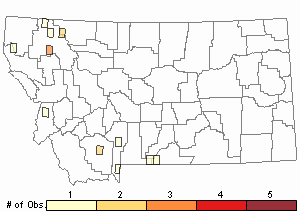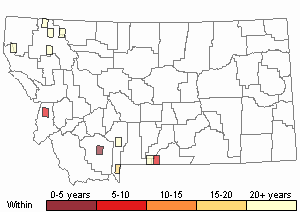View in other NatureServe Network Field Guides
NatureServe
Montana
Utah
Wyoming
Idaho
Wisconsin
British Columbia
South Carolina
Yukon
California
New York
A Warnstorfia Moss - Warnstorfia fluitans
General Description
Plants: Pleurocarpous. Growing in large mats or thick tufts (Crum & Anderson et al. 1981; Lawton 1971), green, green with golden tones, somewhat brown to russet, or seldom red (FNA 2014) with a golden tinge (Crum & Anderson et al. 1981) in very open areas (FNA 2014). Stems 5-15 cm in length, or may be longer in floating plants (Lawton 1971), with few branches (Crum & Anderson et al. 1981); possessing a central strand; hyalodermis wanting; rhizoids or their initials located on stems or leaves in various places (FNA 2014).
Leaves: Somewhat dense, the tips falcate and pointing toward the same side of the stem, or distant and spreading (Crum & Anderson et al. 1981), lanceolate (Lawton 1971) or slenderly ovate, narrowing into a long acumen, curved like a sickle or occasionally straight, moderately to barely cupped (FNA 2014), not furrowed, 2-4 mm in length (Crum & Anderson et al. 1981); margins or parts of the margins toothed or faintly so; (FNA 2014); base not noticeably auriculate (Crum & Anderson et al. 1981); costa ranging from half the leaf length to subpercurrent, sometimes shorter, infrequently paired (FNA 2014).
Leaf Cells: Alar region in a slender, crosswise triangle, not strongly demarcated (FNA 2014), the cells shy of square, somewhat swollen; distal cells long and narrow, flexuose; basal cells at the attachment frequently golden (Crum & Anderson et al. 1981), occasionally pitted, with thick walls (Flowers 1973).
Diagnostic Characteristics
Although fluitans means floating, the plants are connected to the substrate rather than floating (Crum & Anderson et al. 1981).
Plants with sickle-shaped leaf tips and absent of capsules may be confused with comparable Sarmentypnum (or Sarmenthypnum) species. Sarmentypnum plants have alar regions that are more strongly demarcated than those of Warnstorfia. They are also dioicous rather than autoicous and often have red (FNA 2014) or purplish-red colorings rather than red with golden tinges (Crum & Anderson et al. 1981).
The alar areas of the similar W. exannulatum generally extend further distally (FNA 2014).
Range Comments
North American Range
Canada: Known in all provinces and territories except SK and YT; USA: most northeastern states, s to NC, the border then angling nw to MN, also AK and CO. Known in Montana from Beaverhead, Flathead, Gallatin, Glacier, Lincoln, Park, and Sanders Counties (Elliott 2016).
Observations in Montana Natural Heritage Program Database
Number of Observations: 16
(Click on the following maps and charts to see full sized version)
Map Help and Descriptions
Relative Density

Recency



 (Observations spanning multiple months or years are excluded from time charts)
(Observations spanning multiple months or years are excluded from time charts)
Habitat
Ombrotrophic, occasionally in areas with abundant nutrients (somewhat polluted) (FNA 2014); wet soil and humus (Elliott 2016), bogs, fens, rocks in seepy areas or with water-holding cavities (FNA 2014), swamps, lake margins (Flowers 1973), frequently underwater when water is high (Crum & Anderson et al. 1981). Elevation: 0-11,480 feet (FNA 2014).
Reproductive Characteristics
Autoicous (FNA 2014). Sporophytes common. Seta 5-7.5 cm in length. Capsule 2-3 mm in length, bowed, ascending to drooping; cilia in twos (Crum & Anderson et al. 1981).
Stewardship Responsibility
References
- Literature Cited AboveLegend:
 View Online Publication
View Online Publication Crum, H.A. and L.E. Anderson. 1981. Mosses of Eastern North America. 2 volumes. Columbia University Press, New York. 1328 pp.
Crum, H.A. and L.E. Anderson. 1981. Mosses of Eastern North America. 2 volumes. Columbia University Press, New York. 1328 pp. Elliott, J.C. and A.K. Pipp. 2018. A Checklist of Montana Mosses (1880-2018). Updated 3 January, 2020. Montana Natural Heritage Program, Helena, Montana. 73 pp.
Elliott, J.C. and A.K. Pipp. 2018. A Checklist of Montana Mosses (1880-2018). Updated 3 January, 2020. Montana Natural Heritage Program, Helena, Montana. 73 pp. Flora of North America Editorial Committee, eds. 2014. Flora of North America North of Mexico. Volume 28. Bryophytes: Mosses, Part 2. Oxford University Press, Inc., NY. xxi + 702 pp.
Flora of North America Editorial Committee, eds. 2014. Flora of North America North of Mexico. Volume 28. Bryophytes: Mosses, Part 2. Oxford University Press, Inc., NY. xxi + 702 pp. Flowers, S. 1973. Mosses: Utah and the West. Brigham Young University, Provo, Utah. 567 p.
Flowers, S. 1973. Mosses: Utah and the West. Brigham Young University, Provo, Utah. 567 p. Lawton, E. 1971. Moss Flora of the Pacific Northwest. Hattori Botanical Laboratory. Japan: Yamabuki-cho, Shinjuku-ku, Tokyo. 362 pages plus appendices.
Lawton, E. 1971. Moss Flora of the Pacific Northwest. Hattori Botanical Laboratory. Japan: Yamabuki-cho, Shinjuku-ku, Tokyo. 362 pages plus appendices.
- Additional ReferencesLegend:
 View Online Publication
View Online Publication
Do you know of a citation we're missing? Elliot, J. C. 1993. Second checklist of Montana mosses. Unpublished report. U.S. Forest Service, Region 1. Missoula, MT. 45 pp.
Elliot, J. C. 1993. Second checklist of Montana mosses. Unpublished report. U.S. Forest Service, Region 1. Missoula, MT. 45 pp. Lawton, E. 1971. Keys for the Identification of the Mosses on the Pacific Northwest. Reprinted from 'Moss Flora of the Pacific Northwest'. Published as Supplement No. 2 of the Journal of the Hattori Botanical Laboratory. Nichinan, Miyazaki, Japan. 66 pp.
Lawton, E. 1971. Keys for the Identification of the Mosses on the Pacific Northwest. Reprinted from 'Moss Flora of the Pacific Northwest'. Published as Supplement No. 2 of the Journal of the Hattori Botanical Laboratory. Nichinan, Miyazaki, Japan. 66 pp. Malcolm, B., N. Malcolm, J. Shevock, and D. Norris. 2009. California Mosses. Nelson, New Zealand: Micro-Optics Press. 430 pp.
Malcolm, B., N. Malcolm, J. Shevock, and D. Norris. 2009. California Mosses. Nelson, New Zealand: Micro-Optics Press. 430 pp. Smith, A.J.E. 1980. The Moss Flora of Britain and Ireland. Cambridge University Press, Cambridge. 705 pp.
Smith, A.J.E. 1980. The Moss Flora of Britain and Ireland. Cambridge University Press, Cambridge. 705 pp.
- Web Search Engines for Articles on "A Warnstorfia Moss"





